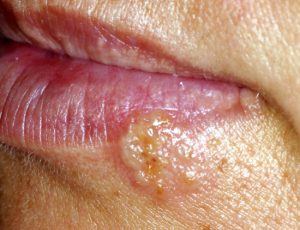
A recurrent or secondary HSV infection refers to the reactivation of a dormant or latent herpes simplex virus in a pre-infected person. The herpes virus lies dormant within the trigeminal nerve ganglion until reactivation. Once reactivated, the virus travels down the nerve fiber to the site where the lesion will appear.
Approximately 90% of the population have been exposed to herpes simplex, type I. Out of the 90% that have herpes simplex, 40% will display outbreaks.
What causes an outbreak to occur on a person will vary. Some of the factors that precipitate outbreaks include stress, sunlight, the common cold, heat, illnesses, immunosuppression, menstruation and trauma. Yes, trauma can mean recent dental treatment (scaling, tooth extraction, etc…).
The majority of herpes simplex outbreaks occur on the lips or surrounding perioral tissues. This type of outbreak is known as herpes labialis or cold sores.
So, let’s talk about how the lesion presents clinically. 75% of the patients that have these outbreaks will exhibit prodromal symptoms (burning, tingling, itching). Within hours, the involved area exhibits redness and edema. The presence of numerous vesicles occurs shortly afterwards. These vesicles rupture and ulcers are left.
Intraoral HSV lesions can also be noted. The clinical findings mentioned above are seen, but the lesions are limited to the keratinized tissues (hard palate, attached gingiva).

